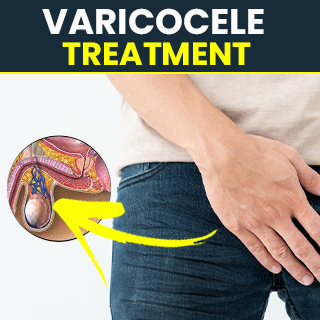Varicocele is a condition characterized by the enlargement of the veins within the scrotum. The veins affected by the varicocele are called the pampiniform plexus, which drain blood from the testicles. When the valves which regulate blood flow do not function properly, blood pools in the veins, leading to their enlargement. Varicoceles mostly develop on the left side of the scrotum, but they can occur on both sides. Many varicoceles are asymptomatic and are discovered during a routine physical examination or fertility evaluation.
The following are the symptoms of varicocele:
Enlarged veins: Varicocele often presents as swollen or enlarged veins in the scrotum. These veins may feel like a "bag of worms" and are usually more noticeable when standing or during physical exertion.
Testicular discomfort or pain: Varicocele can cause dull or throbbing pain in the scrotum, particularly after standing or sitting for long periods. The pain may vary from mild to severe and can worsen over time.
Heaviness or dragging sensation: Some individuals with varicoceles may experience a feeling of heaviness or a dragging sensation in the scrotum.
Testicular atrophy: In certain cases, varicoceles can lead to testicular atrophy or shrinkage of the affected testicle. This can be a result of reduced blood flow and oxygen supply to the testicle.
Fertility issues: Varicoceles may affect sperm production or function, potentially leading to infertility or reduced fertility. Some individuals may experience problems with sperm quality, such as decreased motility or abnormal morphology.
If you suspect these symptoms consult with the doctor and take varicocele treatment.
There are many treatment options available for varicocele, including:
1. Lifestyle changes: This includes various activities of our day-to-day routine in which we have to adapt necessary changes, varicocele natural treatment includes:
a. Avoid prolonged sitting or standing, as it can worsen symptoms.
b. Wear supportive underwear or a scrotal support device to relieve pressure on the
veins.
c. Engage in regular exercise as it improves blood circulation.
2. Modify diet patterns: Make necessary changes in diet patterns that help to alleviate the symptoms of varicocele.
a. Consume a balanced diet rich in fruits, vegetables, whole grains, and lean
Proteins.
b. Avoid excessive consumption of processed foods, sugary snacks, and caffeine.
c. Stay hydrated by drinking an adequate amount of water each day.
vein walls.
3. Nutritional supplements: These supplements helps in the improvement of overall vascular health.
a. Antioxidants: Vitamin C and Vitamin E are antioxidants that can help reduce
Oxidative stress and improve overall vascular health.
b. Omega-3 fatty acids: Found in fish oil or flaxseed oil, they have anti-
inflammatory properties and may promote better blood flow.
5. Therapies: Take hot and cold therapy.
a. Alternating between hot and cold packs on the affected area may help improve
Blood circulation and reduce swelling.
6. Homeopathic treatment: The treatment of varicocele by homeopathy is a medical practice based on the concept of “like cures like.” Medications Considered in homeopathy involve highly diluted substances that are derived from plants, minerals, or animals, which are believed to stimulate the body’s self-healing abilities. This is the best varicocele treatment that patients can opt for. Choose homeopathy for the treatment of varicocele because homeopathic doctors give customized medicines based on the natural product according to the patient's needs. It performs varicocele treatment without surgery homeopathy.




No comments:
Post a Comment